Effect of Hydrogen Addition on the Energetic and Ecologic Parameters of an SI Engine Fueled by Biogas
Abstract
Featured Application
Abstract
1. Introduction
2. Materials and Methods
- A naturally aspirated spark engine with three cylinders, a capacity of 796 cm3, and a compression ratio equal to 9.3. The engine control and power supply systems were modified for the use of biogas and hydrogen mixtures. The engine was tested at 1500 rpm.
- An asynchronous electric motor with a power take-off system, capable of operating as electric motor (starter) and generator (load). The main purpose of this motor is to apply load on the selected point of the operating cycle. All experiments were conducted at Brake Mean Effective Pressure (BMEP) of 0.42 MPa.
- High-pressure cylinders with methane, carbon dioxide, and hydrogen equipped with dual-stage gas regulators.
- A measuring devices for flow rate, temperature, and pressure evaluation, including rotameters, Coriolis- and conductivity-type flow meters, manometers, and thermocouples.
3. Results
4. Conclusions
- The maximum BTE value of 0.314 is reached with the advanced ST and the engine running on a mixture of biogas and 14 vol% hydrogen. Reducing ST to 28 CAD BTDC reduces BTE due to the low combustion speed and biogas combustion delay period. Further increasing the hydrogen concentration reduces the volumetric efficiency of the engine and at the same time reduces the BTE.
- In all cases, adding hydrogen to biogas increases NOx emissions. This is because of the increase in cylinder pressure and the temperature of burning fuel mixture with higher LHV. The advanced ST increases NOx emissions further, because the combustion process forms peak pressure earlier and the in-cylinder temperature rises. This is also confirmed by the drop in exhaust gas temperature as a result of less burning fuel passing through the exhaust valve when ST is advanced.
- Increased concentration of hydrogen improves the combustion process and decreases the amount of unburn fuel in the exhaust gases. At a maximum hydrogen concentration of 43 vol% and ST of 28 CAD BTDC emissions of HC fall by 40%; this is because of the lower ratio of carbon molecules inside the fuel mixture and the increased quality of combustion. In the cases of advanced ST, HC emissions rise because of the lower exhaust temperatures, which reduce the oxidation reaction of unburned HC speed.
- Reduction of GHG is also noticeable when adding H2, which reduces fuel consumption and carbon molecules in fuel mixture. In the case of 43 vol% hydrogen, CO2 emissions dropped by 8.36% when ST was set to 28 CAD BTDC and by 6.96% when ST was 24 CAD BTDC.
- The peak of the in-cylinder pressure increases with the addition of hydrogen, and it occurs closer to TDC due to the higher flame speed of added hydrogen. In the case of the highest hydrogen concentration, the value of ST 28 CAD BTDC is optimal for CNG and for the biogas–hydrogen mixture. Further reduction of ST to 24 CAD BTDC is not necessary, as the peak value of the in-cylinder pressure shifts further from TDC, and the maximum value decreases.
- ROHR increases with every portion of hydrogen, and the maximum value is reached earlier because of the increased fuel mixture’s LHV and the intensity of combustion. This is also confirmed by the increase in the in-cylinder temperature. In the maximum BTE case (ST 28 CAD BTDC, 14 vol% H2), the increase in peak temperature reached 53.3 K/CAD at 7 CAD, and the advanced ST increased it further to 55.4 K/CAD at 1 CAD. This change also influences the increase in NOx emission.
Author Contributions
Funding
Institutional Review Board Statement
Informed Consent Statement
Data Availability Statement
Acknowledgments
Conflicts of Interest
References
- European Comission. Commission Publishes Strategy for Low-Emission Mobility. Available online: https://ec.europa.eu/transport/themes/strategies/news/2016-07-20-decarbonisation_en (accessed on 18 April 2020).
- European Environment Agency. Annual European Union Greenhouse Gas Inventory 1990–2017 and Inventory Report 2019. Available online: https://www.eea.europa.eu/publications/european-union-greenhouse-gas-inventory-2019 (accessed on 18 April 2020).
- European Comission. EU Reference Scenario 2016: Energy, Transport and GHG Emissions: Trends to 2050. Available online: http://op.europa.eu/en/publication-detail/-/publication/aed45f8e-63e3-47fb-9440-a0a14370f243/language-en/format-PDF (accessed on 18 April 2020).
- European Union. WHITE PAPER Roadmap to a Single European Transport Area—Towards a Competitive and Resource Efficient Transport System. Available online: https://eur-lex.europa.eu/legal-content/EN/TXT/HTML/?uri=CELEX:52011DC0144&from=en (accessed on 19 April 2020).
- Rimkus, A.; Stravinskas, S.; Matijošius, J. Comparative study on the energetic and ecologic parameters of dual fuels (Diesel–NG and HVO–Biogas) and conventional diesel fuel in a CI engine. Appl. Sci. 2020, 10, 359. [Google Scholar] [CrossRef]
- Lee, S.; Park, S.; Kim, C.; Kim, Y.-M.; Kim, Y.; Park, C. Comparative study on EGR and lean burn strategies employed in an SI engine fueled by low calorific Gas. Appl. Energy 2014, 129, 10–16. [Google Scholar] [CrossRef]
- Puskar, M.; Jahnatek, A.; Kuric, I.; Kadarova, J.; Kopas, M.; Soltesova, M. Complex analysis focused on influence of biodiesel and its mixture on regulated and unregulated emissions of motor vehicles with the aim to protect air quality and environment. Air Qual. Atmos. Health 2019, 12, 855–864. [Google Scholar] [CrossRef]
- Caban, J.; Gniecka, A.; Holesa, L. Alternative fuels for diesel engines. Adv. Sci. Technol. Res. J. 2013, 7, 20–70. [Google Scholar] [CrossRef]
- Göktaş, M.; Kemal Balki, M.; Sayin, C.; Canakci, M. An Evaluation of the use of alcohol fuels in SI engines in terms of performance, emission and combustion characteristics: A review. Fuel 2021, 286, 119425. [Google Scholar] [CrossRef]
- Hao, D.; Mehra, R.K.; Luo, S.; Nie, Z.; Ren, X.; Fanhua, M. Experimental study of hydrogen enriched compressed natural gas (HCNG) Engine and Application of Support Vector Machine (SVM) on Prediction of Engine Performance at Specific Condition. Int. J. Hydrog. Energy 2020, 45, 5309–5325. [Google Scholar] [CrossRef]
- Park, J.; Song, S. Predicting the performance and NOx emissions of a turbocharged spark-ignition engine generator fueled with biogases and hydrogen addition under down-boosting condition. Int. J. Hydrog. Energy 2014, 39, 8510–8524. [Google Scholar] [CrossRef]
- Khan, I.; Hafiz, M.; Othman, M.H.; Hashim, H.; Matsuura, T.; Ismail, A.; Rezaei Dasht Arzhandi, M.; Wan Azelee, I. Biogas as a renewable energy fuel—A review of biogas upgrading, utilisation and storage. Energy Convers. Manag. 2017, 150, 277–294. [Google Scholar] [CrossRef]
- Qyyum, M.A.; Haider, J.; Qadeer, K.; Valentina, V.; Khan, A.; Yasin, M.; Aslam, M.; De Guido, G.; Pellegrini, L.A.; Lee, M. Biogas to liquefied biomethane: Assessment of 3P’s–production, processing, and prospects. Renew. Sustain. Energy Rev. 2020, 119, 109561. [Google Scholar] [CrossRef]
- European Comission. Eurostat Generation of Waste by Waste Category. Available online: https://appsso.eurostat.ec.europa.eu/nui/submitViewTableAction.do (accessed on 18 May 2020).
- Zabed, H.M.; Akter, S.; Yun, J.; Zhang, G.; Zhang, Y.; Qi, X. Biogas from microalgae: Technologies, challenges and opportunities. Renew. Sustain. Energy Rev. 2020, 117, 109503. [Google Scholar] [CrossRef]
- Saady, N.M.C.; Massé, D.I. Psychrophilic anaerobic digestion of lignocellulosic biomass: A characterization study. Bioresour. Technol. 2013, 142, 663–671. [Google Scholar] [CrossRef]
- Wang, Z.; Xu, F.; Li, Y. Effects of total ammonia nitrogen concentration on solid-state anaerobic digestion of corn stover. Bioresour. Technol. 2013, 144, 281–287. [Google Scholar] [CrossRef]
- Li, Y.; Zhang, R.; Liu, G.; Chen, C.; He, Y.; Liu, X. Comparison of methane production potential, biodegradability, and kinetics of different organic substrates. Bioresour. Technol. 2013, 149, 565–569. [Google Scholar] [CrossRef]
- Xu, F.; Wang, Z.-W.; Li, Y. Predicting the methane yield of lignocellulosic biomass in mesophilic solid-state anaerobic digestion based on deedstock characteristics and process parameters. Bioresour. Technol. 2014, 173, 168–176. [Google Scholar] [CrossRef] [PubMed]
- Zhang, C.; Xiao, G.; Peng, L.; Su, H.; Tan, T. The anaerobic co-digestion of food waste and cattle manure. Bioresour. Technol. 2013, 129, 170–176. [Google Scholar] [CrossRef] [PubMed]
- Kawai, M.; Nagao, N.; Tajima, N.; Niwa, C.; Matsuyama, T.; Toda, T. The effect of the labile organic fraction in food waste and the substrate/inoculum ratio on anaerobic digestion for a reliable methane yield. Bioresour. Technol. 2014, 157, 174–180. [Google Scholar] [CrossRef] [PubMed]
- Bharathiraja, D.B.; Sudharsanaa, T.; Bharghavi, A.; Jayamuthunagai, J.; Ramanujam, P.K. Biohydrogen and biogas—An overview on feedstocks and enhancement process. Fuel 2016, 185, 810–828. [Google Scholar] [CrossRef]
- Khalil, M.; Berawi, M.A.; Heryanto, R.; Rizalie, A. Waste to energy technology: The potential of sustainable biogas production from animal waste in Indonesia. Renew. Sustain. Energy Rev. 2019, 105, 323–331. [Google Scholar] [CrossRef]
- Zupančič, G.; Panjičko, M.; Zelić, B. Biogas production from brewer’s yeast using an anaerobic sequencing batch reactor. Food Technol. Biotechnol. 2017, 55, 187–196. [Google Scholar] [CrossRef]
- Achinas, S.; Achinas, V.; Euverink, G.J.W. A technological overview of biogas production from biowaste. Engineering 2017, 3, 299–307. [Google Scholar] [CrossRef]
- Mähnert, P.; Linke, B. Kinetic study of biogas production from energy crops and animal waste slurry: Effect of organic loading rate and reactor size. Environ. Technol. 2009, 30, 93–99. [Google Scholar] [CrossRef] [PubMed]
- Eurobserv-er. EurObserv’ER Biogas Barometer 2017. Available online: https://www.eurobserv-er.org/biogas-barometer-2017/ (accessed on 1 May 2020).
- European Biogas Association. EBA Annual Report 2019. Available online: https://www.europeanbiogas.eu/eba-annual-report-2019/ (accessed on 18 May 2020).
- European Biogas Association. EBA Statistical Report 2018. Available online: https://www.europeanbiogas.eu/wp-content/uploads/2019/11/EBA_report2018_abriged_A4_vers12_220519_RZweb.pdf (accessed on 18 May 2020).
- Hosseini, S.E.; Wahid, M.A. Utilization of biogas released from palm oil mill effluent for power generation using self-preheated reactor. Energy Convers. Manag. 2015, 105, 957–966. [Google Scholar] [CrossRef]
- Kapoor, R.; Ghosh, P.; Tyagi, B.; Vijay, V.K.; Vijay, V.; Thakur, I.S.; Kamyab, H.; Nguyen, D.D.; Kumar, A. Advances in biogas valorization and utilization systems: A comprehensive review. J. Clean. Prod. 2020, 273, 123052. [Google Scholar] [CrossRef]
- Kollamthodi, S. The role of natural gas and biomethane in the transport sector. Rep. Transp. Environ. 2016, 1, 85. [Google Scholar]
- Paolini, V.; Petracchini, F.; Segreto, M.; Tomassetti, L.; Naja, N.; Cecinato, A. Environmental impact of biogas: A short review of current knowledge. J. Environ. Sci. Health Part A 2018, 53, 899–906. [Google Scholar] [CrossRef]
- Khatri, N.; Khatri, K.K. Hydrogen enrichment on diesel engine with biogas in dual fuel mode. Int. J. Hydrog. Energy 2020, 45, 7128–7140. [Google Scholar] [CrossRef]
- Subramanian, K.A.; Mathad, V.C.; Vijay, V.K.; Subbarao, P.M.V. Comparative evaluation of emission and fuel economy of an automotive spark ignition vehicle fuelled with methane enriched biogas and CNG using chassis dynamometer. Appl. Energy 2013, 105, 17–29. [Google Scholar] [CrossRef]
- Wei, Z.L.; Leung, C.W.; Cheung, C.S.; Huang, Z.H. Effects of Equivalence Ratio, H2 and CO2 Addition on the heat release characteristics of premixed laminar biogas-hydrogen flame. Int. J. Hydrog. Energy 2016, 41, 6567–6580. [Google Scholar] [CrossRef]
- Verma, S.; Das, L.M.; Kaushik, S.C.; Bhatti, S.S. The effects of compression ratio and EGR on the performance and emission characteristics of diesel-biogas dual fuel engine. Appl. Therm. Eng. 2019, 150, 1090–1103. [Google Scholar] [CrossRef]
- Yoon, S.H.; Lee, C.S. Experimental investigation on the combustion and exhaust emission characteristics of biogas–biodiesel dual-fuel combustion in a CI engine. Fuel Process. Technol. 2011, 92, 992–1000. [Google Scholar] [CrossRef]
- Hotta, S.K.; Sahoo, N.; Mohanty, K. Comparative assessment of a spark ignition engine fueled with gasoline and raw biogas. Renew. Energy 2019, 134, 1307–1319. [Google Scholar] [CrossRef]
- Porpatham, E.; Ramesh, A.; Nagalingam, B. Effect of swirl on the performance and combustion of a biogas fuelled spark ignition engine. Energy Convers. Manag. 2013, 76, 463–471. [Google Scholar] [CrossRef]
- Kwon, E.-C.; Song, K.; Kim, M.; Shin, Y.; Choi, S. Performance of small spark ignition engine fueled with biogas at different compression ratio and various carbon dioxide dilution. Fuel 2017, 196, 217–224. [Google Scholar] [CrossRef]
- Siripornakarachai, S. Conversion of large diesel engine to run on biogas for high efficiency electrical power generation. AMA Agric. Mech. Asia Afr. Lat. Am. 2009, 40, 59–63. [Google Scholar]
- Porpatham, E.; Ramesh, A.; Nagalingam, B. Investigation on the effect of concentration of methane in biogas when used as a fuel for a spark ignition engine. Fuel 2008, 87, 1651–1659. [Google Scholar] [CrossRef]
- Porpatham, E.; Ramesh, A.; Nagalingam, B. Effect of hydrogen addition on the performance of a biogas fuelled spark ignition engine. Int. J. Hydrog. Energy 2007, 32, 2057–2065. [Google Scholar] [CrossRef]
- Hotta, S.K.; Sahoo, N.; Mohanty, K.; Kulkarni, V. Ignition timing and compression ratio as effective means for the improvement in the operating characteristics of a biogas fueled spark ignition engine. Renew. Energy 2020, 150, 854–867. [Google Scholar] [CrossRef]
- Kan, X.; Zhou, D.; Yang, W.; Zhai, X.; Wang, C.-H. An investigation on utilization of biogas and syngas produced from biomass waste in premixed spark ignition engine. Appl. Energy 2018, 212, 210–222. [Google Scholar] [CrossRef]
- Nges, I.A.; Escobar, F.; Fu, X.; Björnsson, L. Benefits of supplementing an industrial waste anaerobic digester with energy crops for increased biogas production. Waste Manag. 2012, 32, 53–59. [Google Scholar] [CrossRef]
- Byun, J.S.; Park, J. Predicting the performance and exhaust NOX emissions of a spark-ignition engine generator fueled with methane based biogases containing various amounts of CO2. J. Nat. Gas Sci. Eng. 2015, 22, 196–202. [Google Scholar] [CrossRef]
- Hoseini, S.S.; Najafi, G.; Ghobadian, B.; Ebadi, M.T.; Mamat, R.; Yusaf, T. Performance and emission characteristics of a CI engine using graphene oxide (GO) nano-particles additives in biodiesel-diesel blends. Renew. Energy 2020, 145, 458–465. [Google Scholar] [CrossRef]
- Soudagar, M.E.M.; Nik-Ghazali, N.-N.; Kalam, M.A.; Badruddin, I.A.; Banapurmath, N.R.; Bin Ali, M.A.; Kamangar, S.; Cho, H.M.; Akram, N. An investigation on the influence of aluminium oxide nano-additive and Honge oil methyl ester on engine performance, combustion and emission characteristics. Renew. Energy 2020, 146, 2291–2307. [Google Scholar] [CrossRef]
- Elseesy, A.; Hassan, H. Combustion characteristics of a diesel engine fueled by biodiesel-diesel-N-butanol blend and titanium oxide additives. Energy Procedia 2019, 162, 48–56. [Google Scholar] [CrossRef]
- Chandra, R.; Vijay, V.K.; Subbarao, P.M.V.; Khura, T.K. Performance evaluation of a constant speed IC engine on CNG, methane enriched biogas and biogas. Appl. Energy 2011, 88, 3969–3977. [Google Scholar] [CrossRef]
- Elfasakhany, A. Investigations on performance and pollutant emissions of spark-ignition engines fueled with n-Butanol–, Isobutanol–, Ethanol–, Methanol–, and Acetone–gasoline blends: A comparative study. Renew. Sustain. Energy Rev. 2016, 71. [Google Scholar] [CrossRef]
- Li, Y.; Chen, Y.; Wu, G.; Lee, C.F.; Liu, J. Experimental comparison of Acetone-n-Butanol-Ethanol (ABE) and Isopropanol-n-Butanol-Ethanol (IBE) as fuel candidate in spark-ignition engine. Appl. Therm. Eng. 2018, 133, 179–187. [Google Scholar] [CrossRef]
- Singh, S.; Jain, S.; Ps, V.; Tiwari, A.K.; Nouni, M.R.; Pandey, J.K.; Goel, S. Hydrogen: A sustainable fuel for future of the transport sector. Renew. Sustain. Energy Rev. 2015, 51, 623–633. [Google Scholar] [CrossRef]
- Zhao, L.; Wang, D.; Qi, W. Comparative study on air dilution and hydrogen-enriched air dilution employed in a SI engine fueled with Iso-Butanol-gasoline. Int. J. Hydrog. Energy 2020, 45, 10895–10905. [Google Scholar] [CrossRef]
- Leung, T.; Wierzba, I. The effect of hydrogen addition on biogas non-premixed jet flame stability in a co-flowing air stream. Int. J. Hydrog. Energy 2008, 33, 3856–3862. [Google Scholar] [CrossRef]
- Wei, Z.L.; Leung, C.W.; Cheung, C.S.; Huang, Z.H. Effects of H2 and CO2 addition on the heat transfer characteristics of laminar premixed biogas–hydrogen Bunsen flame. Int. J. Heat Mass Transf. 2016, 98, 359–366. [Google Scholar] [CrossRef]
- Gómez Montoya, J.P.; Amell, A.A.; Olsen, D.B.; Amador Diaz, G.J. Strategies to improve the performance of a spark ignition engine using fuel blends of biogas with natural gas, Propane and Hydrogen. Int. J. Hydrog. Energy 2018, 43, 21592–21602. [Google Scholar] [CrossRef]
- You, J.; Liu, Z.; Wang, Z.; Wang, D.; Xu, Y. Experimental analysis of inert gases in EGR on engine power and combustion characteristics in a stoichiometric dual fuel heavy-duty natural gas engine ignited with diesel. Appl. Therm. Eng. 2020, 180, 115860. [Google Scholar] [CrossRef]
- Dhyani, V.; Subramanian, K.A. Experimental based comparative exergy analysis of a multi-cylinder spark ignition engine fuelled with different gaseous (CNG, HCNG, and hydrogen) fuels. Int. J. Hydrog. Energy 2019, 44, 20440–20451. [Google Scholar] [CrossRef]
- Wasiu, S.; Aziz, R.A.; Megat, P. Brake specific energy consumption (BSEC) and emission characteristics of the direct injection spark ignition engine fuelled by hydrogen enriched compressed natural gas at various air-fuel ratios. Int. J. Appl. Eng. Res. 2018, 13, 677–683. [Google Scholar]
- Korsakas, V.; Melaika, M.; Pukalskas, S.; Stravinskas, P. Hydrogen addition influence for the efficient and ecological parameters of heavy-duty natural gas Si engine. Procedia Eng. 2017, 187, 395–401. [Google Scholar] [CrossRef]
- Zhang, K.; Jiang, X. An assessment of fuel variability effect on biogas-hydrogen combustion using uncertainty quantification. Int. J. Hydrog. Energy 2018, 43, 12499–12515. [Google Scholar] [CrossRef]
- Nadaleti, W.C.; Przybyla, G. NOx, CO and HC emissions and thermodynamic-energetic efficiency of an SI gas engine powered by gases simulated from biomass gasification under different H2 content. Int. J. Hydrog. Energy 2020, 45, 21920–21939. [Google Scholar] [CrossRef]
- Prasad, R.K.; Agarwal, A.K. Development and comparative experimental investigations of laser plasma and spark plasma ignited hydrogen enriched compressed natural gas fueled engine. Energy 2020, 119282. [Google Scholar] [CrossRef]
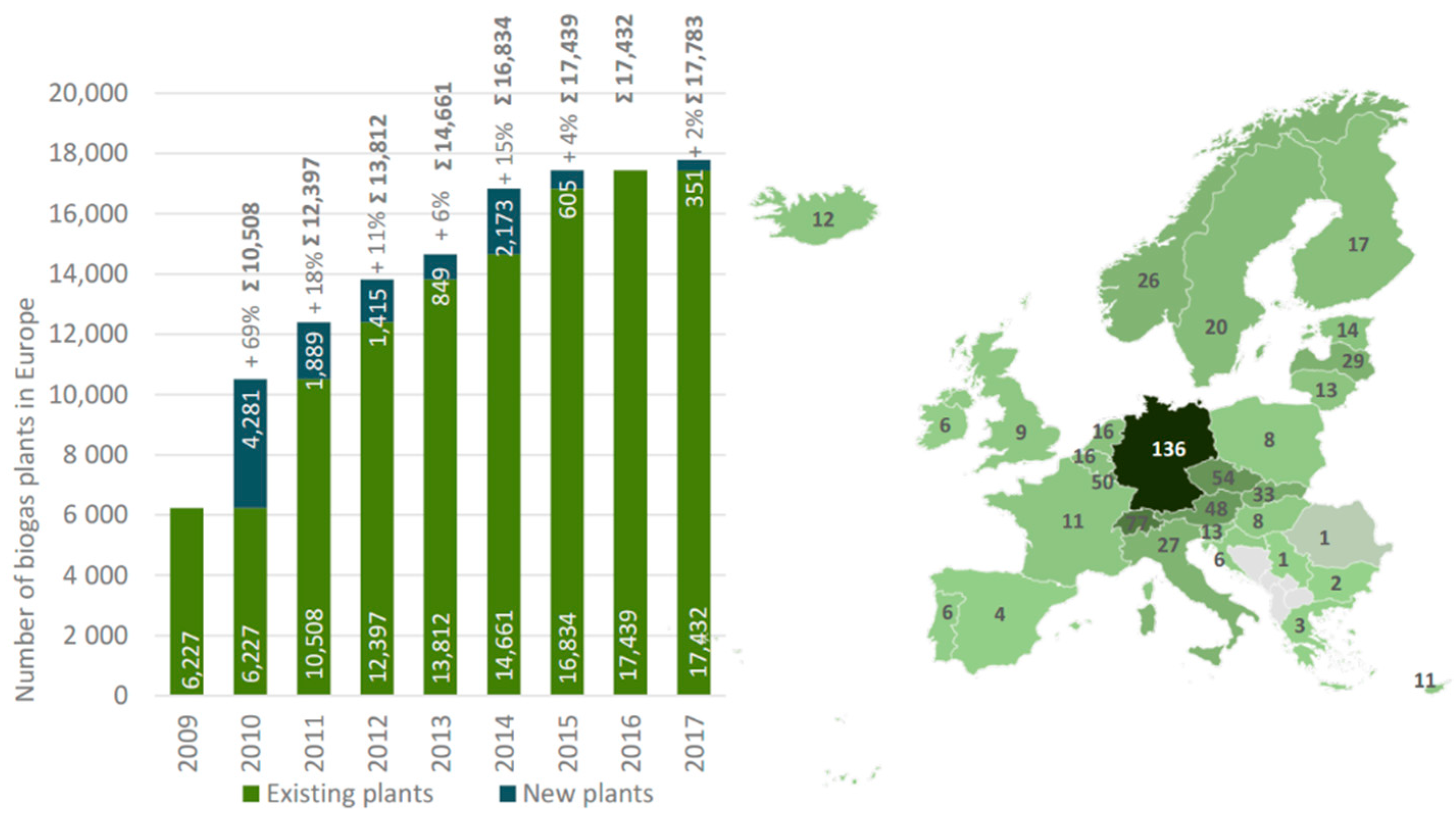
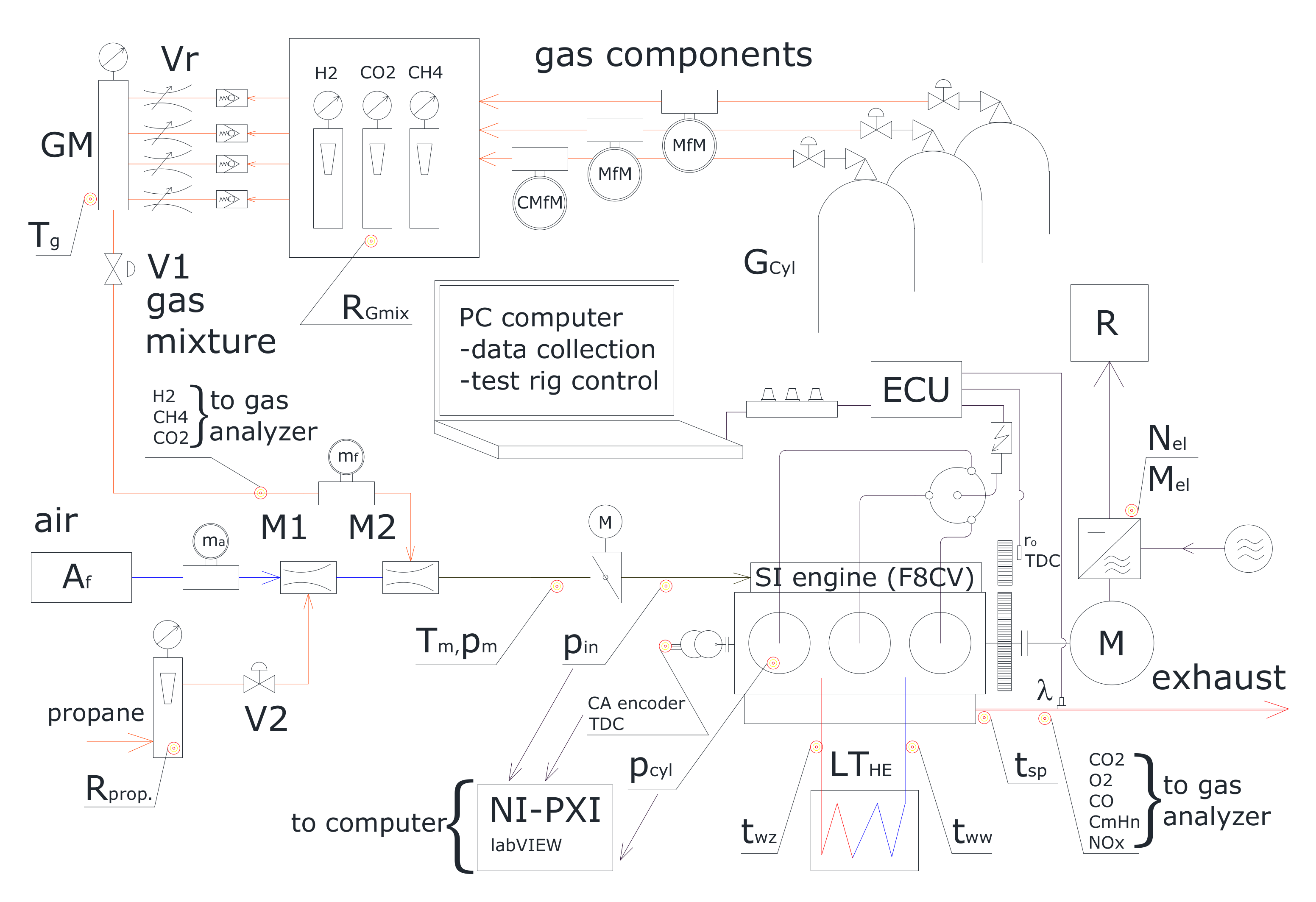
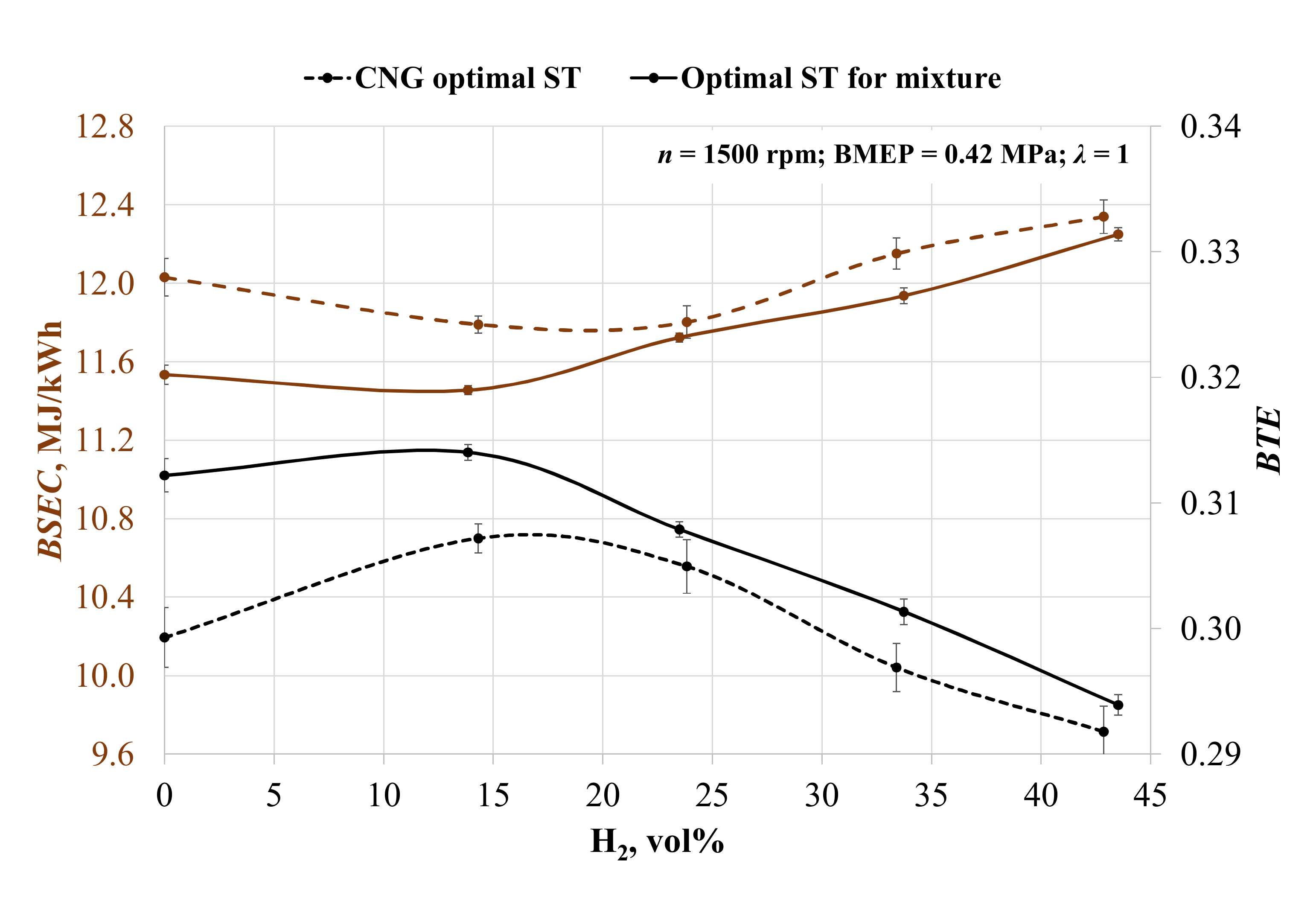
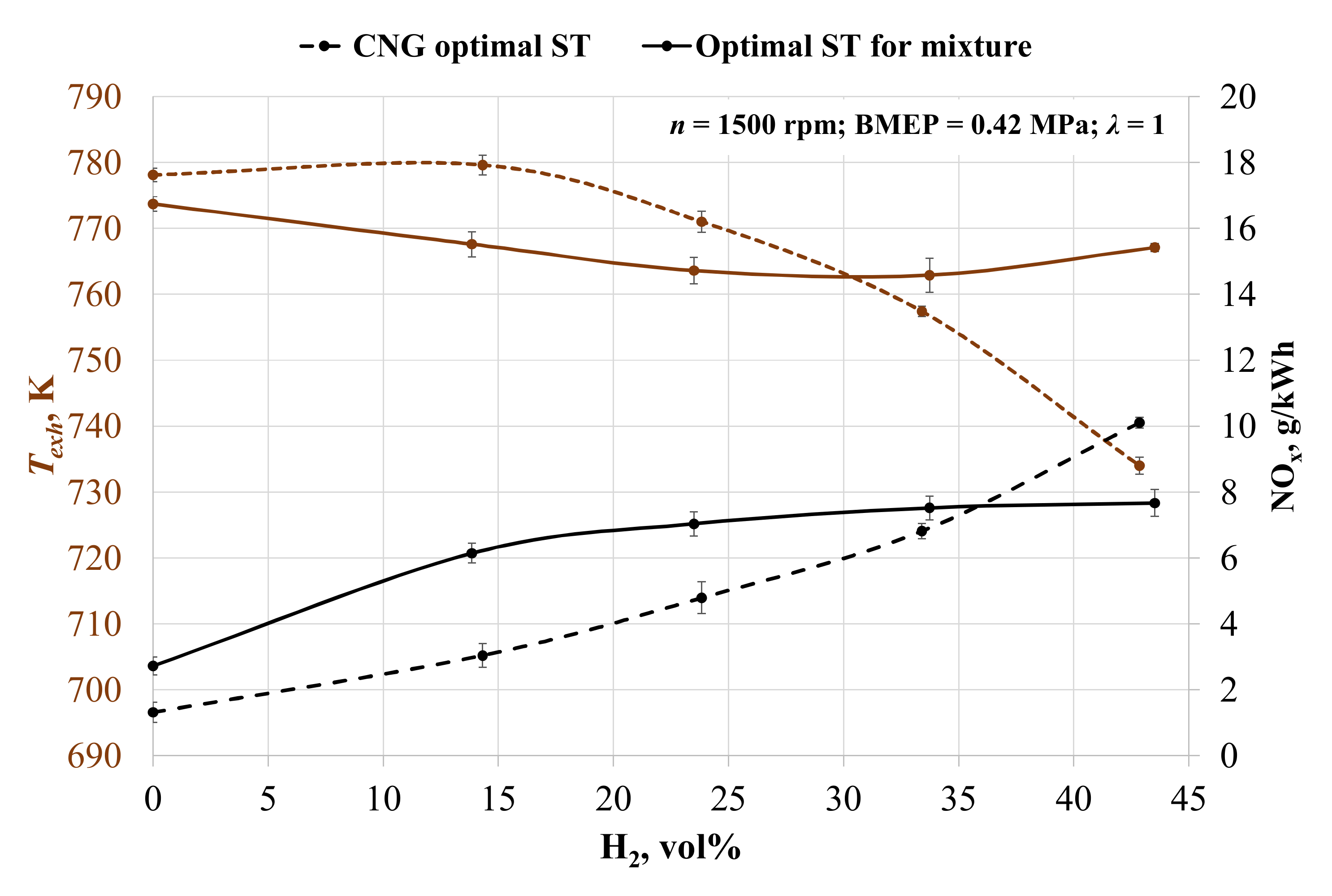



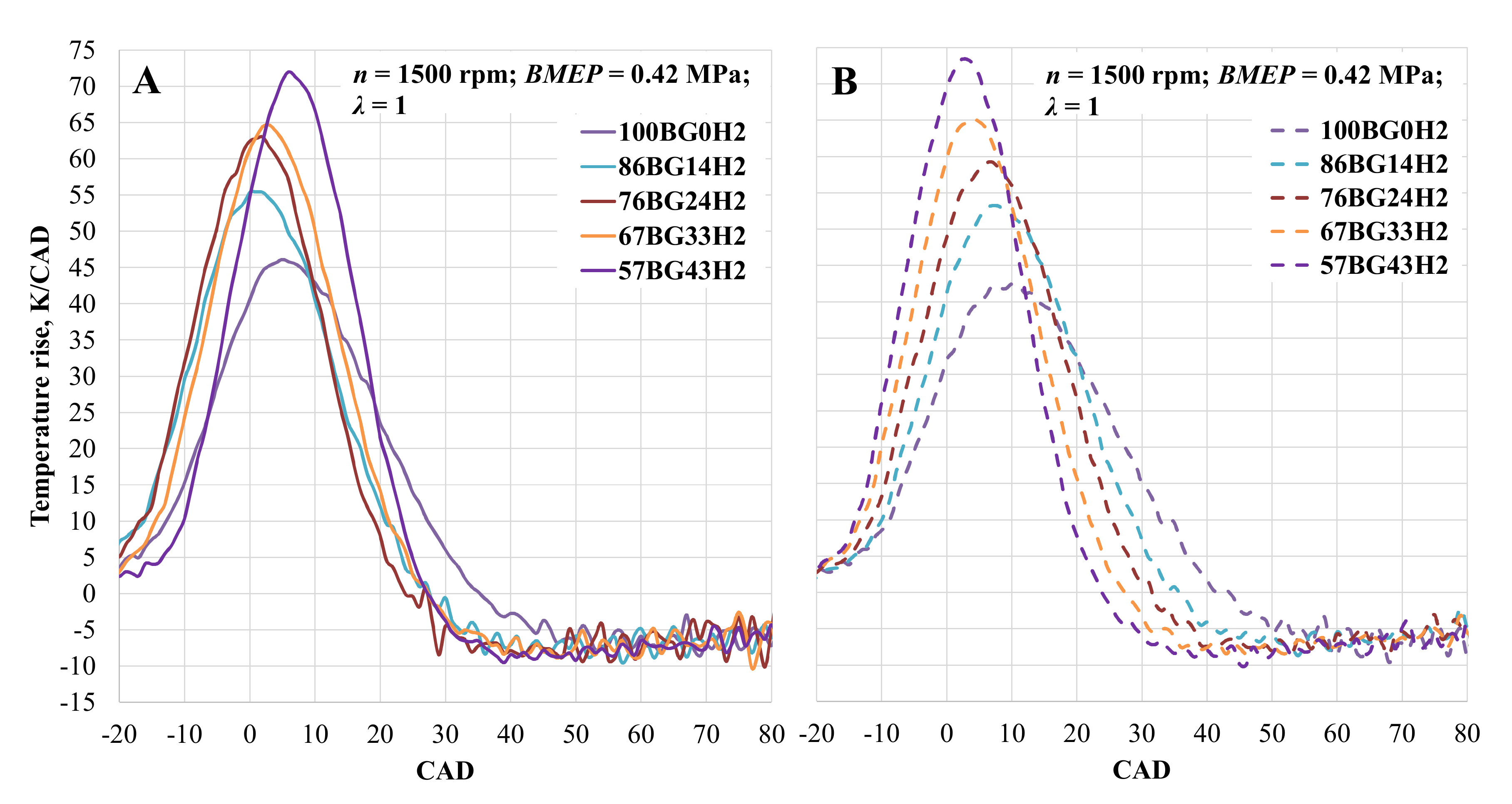
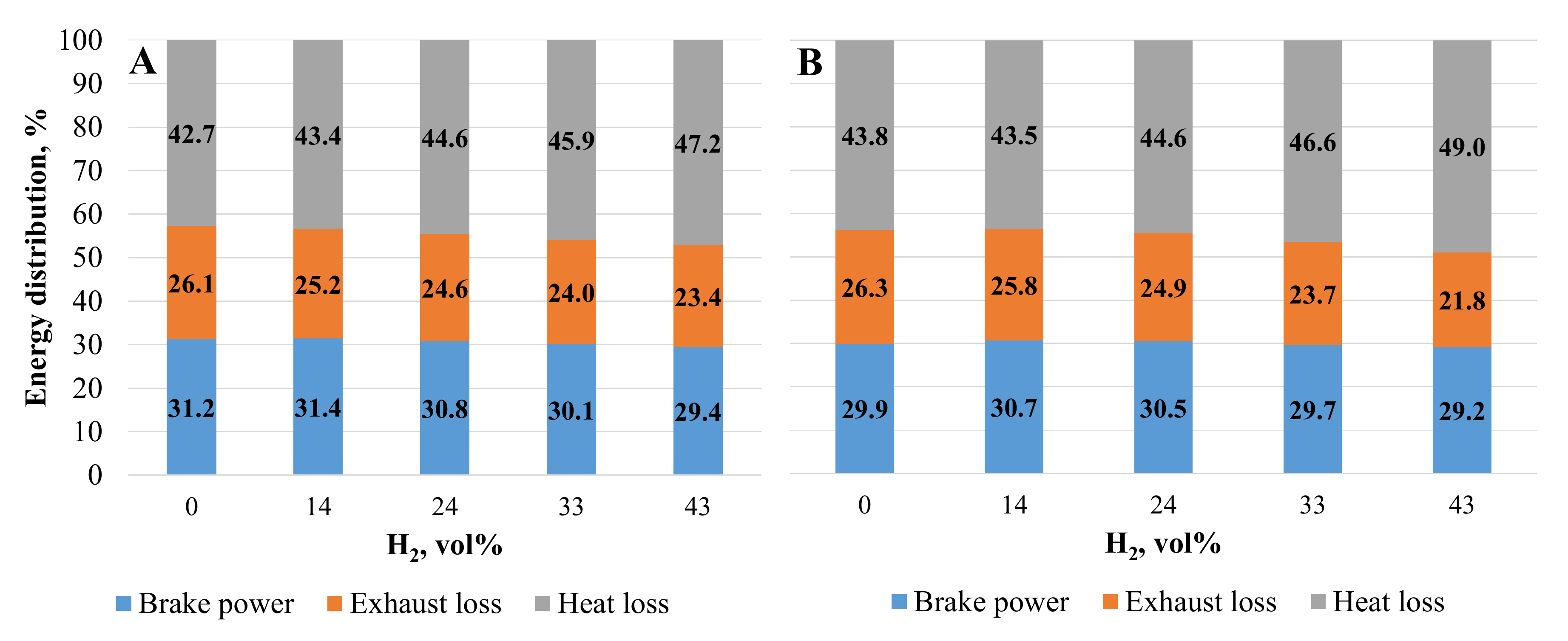
| Biogas | CH4 (vol%) | CO2 (vol%) | N2 (vol%) | O2 (vol%) | H2S (ppm) |
|---|---|---|---|---|---|
| Landfills | 45–62 | 24–40 | 1–17 | 1–2.6 | 15–427 |
| Sewage digester | 58–65 | 33–40 | 1–8 | <1 | 0–24 |
| Organic waste digesters | 60–70 | 30–40 | 1 | 1–5 | 10–180 |
| Raw Material | Biogas Production (m3/kg) | Ref. |
|---|---|---|
| Corn residues | 0.563 | [15] |
| Wheat straws | 0.408–0.483 | [15,16] |
| Rice straws | 0.468–0.503 | [15,17] |
| Sugarcane wastes | 0.463 | [15] |
| Lignocellulose biomass | 0.178–0.402 | [17,18] |
| Switch grass | 0.208 | [19] |
| Pine wood | 0.033 | [19] |
| Food wastes | 0.683–0.725 | [20,21] |
| Nonedible oil seed cakes | 0.242 | [22] |
| Bagasse | 0.330 | [22] |
| Dry leaves | 0.118 | [22] |
| Manure | 0.129 | [23] |
| Brewer’s yeast | 0.430 | [24] |
| Dry maize | 0.397 | [25] |
| Cattle slurry | 0.370 | [26] |
| Maize silage, whole-crop rye silage, and fodder beet silage | 0.610 | [26] |
| CH4, vol% | CO2, vol% | H2, vol% | LHV1, MJ/kg | Marking | ST 2, CAD BTDC 3 | |
|---|---|---|---|---|---|---|
| Optimal for CNG 4 | Optimal for Mixture | |||||
| 61.88 | 38.12 | 0.00 | 17.51 | 100BG0H2 | 28 | 36 |
| 54.06 | 31.86 | 14.08 | 19.31 | 86BG14H2 | 28 | 36 |
| 47.51 | 28.82 | 23.66 | 20.09 | 76BG24H2 | 28 | 34 |
| 41.47 | 25.37 | 33.15 | 21.39 | 67BG33H2 | 28 | 30 |
| 35.66 | 21.15 | 43.19 | 23.68 | 57BG43H2 | 28 | 24 |
| Parameter | Measuring Range | Accuracy |
|---|---|---|
| CO | 0 ÷ 10,5%, by vol. | ±3% |
| CO2 | 0 ÷ 21%, by vol. | ±4% |
| HC 1 | 0 ÷ 20 000 ppm, (equivalent of C6H14), by vol. | ±5% |
| NOx | 0 ÷ 10 000 ppm, by vol. | ±1% |
| O2 | 0 ÷ 21%, by vol. | ±3% |
| Fuel Mixture | Start of Combustion, CAD BTDC 1 | 10% MBF 2, CAD BTDC | 50% MBF, CAD ATDC 3 | 90% MBF, CAD ATDC | ||||
|---|---|---|---|---|---|---|---|---|
| Optimal CNG | Optimal Mixture | Optimal CNG | Optimal Mixture | Optimal CNG | Optimal Mixture | Optimal CNG | Optimal Mixture | |
| 100BG0H2 | 18.1 | 20.4 | −2.0 | 1.8 | 19.4 | 15.0 | 50.1 | 48.9 |
| 86BG14H2 | 19.0 | 21.2 | −0.1 | 5.6 | 15.6 | 9.4 | 45.8 | 46.1 |
| 76BG24H2 | 19.8 | 20.1 | 1.0 | 5.7 | 13.3 | 9.0 | 41.9 | 45.0 |
| 67BG33H2 | 20.5 | 19.6 | 2.8 | 3.8 | 11.0 | 10.1 | 46.9 | 43.9 |
| 57BG43H2 | 20.6 | 17.2 | 3.9 | 0.9 | 8.9 | 12.2 | 43.9 | 44.9 |
Publisher’s Note: MDPI stays neutral with regard to jurisdictional claims in published maps and institutional affiliations. |
© 2021 by the authors. Licensee MDPI, Basel, Switzerland. This article is an open access article distributed under the terms and conditions of the Creative Commons Attribution (CC BY) license (http://creativecommons.org/licenses/by/4.0/).
Share and Cite
Pukalskas, S.; Kriaučiūnas, D.; Rimkus, A.; Przybyła, G.; Droździel, P.; Barta, D. Effect of Hydrogen Addition on the Energetic and Ecologic Parameters of an SI Engine Fueled by Biogas. Appl. Sci. 2021, 11, 742. https://doi.org/10.3390/app11020742
Pukalskas S, Kriaučiūnas D, Rimkus A, Przybyła G, Droździel P, Barta D. Effect of Hydrogen Addition on the Energetic and Ecologic Parameters of an SI Engine Fueled by Biogas. Applied Sciences. 2021; 11(2):742. https://doi.org/10.3390/app11020742
Chicago/Turabian StylePukalskas, Saugirdas, Donatas Kriaučiūnas, Alfredas Rimkus, Grzegorz Przybyła, Paweł Droździel, and Dalibor Barta. 2021. "Effect of Hydrogen Addition on the Energetic and Ecologic Parameters of an SI Engine Fueled by Biogas" Applied Sciences 11, no. 2: 742. https://doi.org/10.3390/app11020742
APA StylePukalskas, S., Kriaučiūnas, D., Rimkus, A., Przybyła, G., Droździel, P., & Barta, D. (2021). Effect of Hydrogen Addition on the Energetic and Ecologic Parameters of an SI Engine Fueled by Biogas. Applied Sciences, 11(2), 742. https://doi.org/10.3390/app11020742







